
Introduction
“In 2015, 193 united nations countries including Japan adopted the 2030 agenda for sustainable development and its 17 sustainable development goals.*¹
Two of the 17 goals are “”Affordable and clean energy “” and “”Climate action””. In order to achieve these goals, it is necessary to create a society that does not rely solely on conventional fossil fuels and nuclear power.
Since the oil shock of 1973, energy consumption has increased 1.2 times in the total and 1.9 times in the household sector, especially in homes and office buildings.
We strong believe that use of heat storage materials with use of passive energy such as elimination of time lag between supply and demand for energy consumed in the corresponding temperature range, delay speed of energy consumption, sunlight and temperature difference between day and night are a strong effective and clean method of energy generation.
Technology that temporarily stores heat and extracts that heat as needed is called “heat storage ”. Heat storage has been researched and developed in various ways and is increasingly being used for air conditioning in homes and buildings. We believe that there are much more applications that can contribute to energy saving and energy management.
Our mission is continuing to develop technologies and propose next-generation energy management materials.”
What is Thermal Storage Material?
Thermal Storage
Thermal storage is storing the heat which allows you to use the heat once stored when needed to reduce the heat-source capacity. It is also useful for transportation for it can store heat corresponding to the air condition so installing or running the heat-source will be unnecessary.
Examples of making use of thermal storage are putting a cold insulator in a cooling box, storing warm water in a hot-water supply system using nighttime electric, or storing heat in bricks that also use nighttime electric power.
The medium used for storing heat are water(ice) in the thermal storage tank, latent heat thermal storage materials, underground, buildings, bricks and concretes, and others.
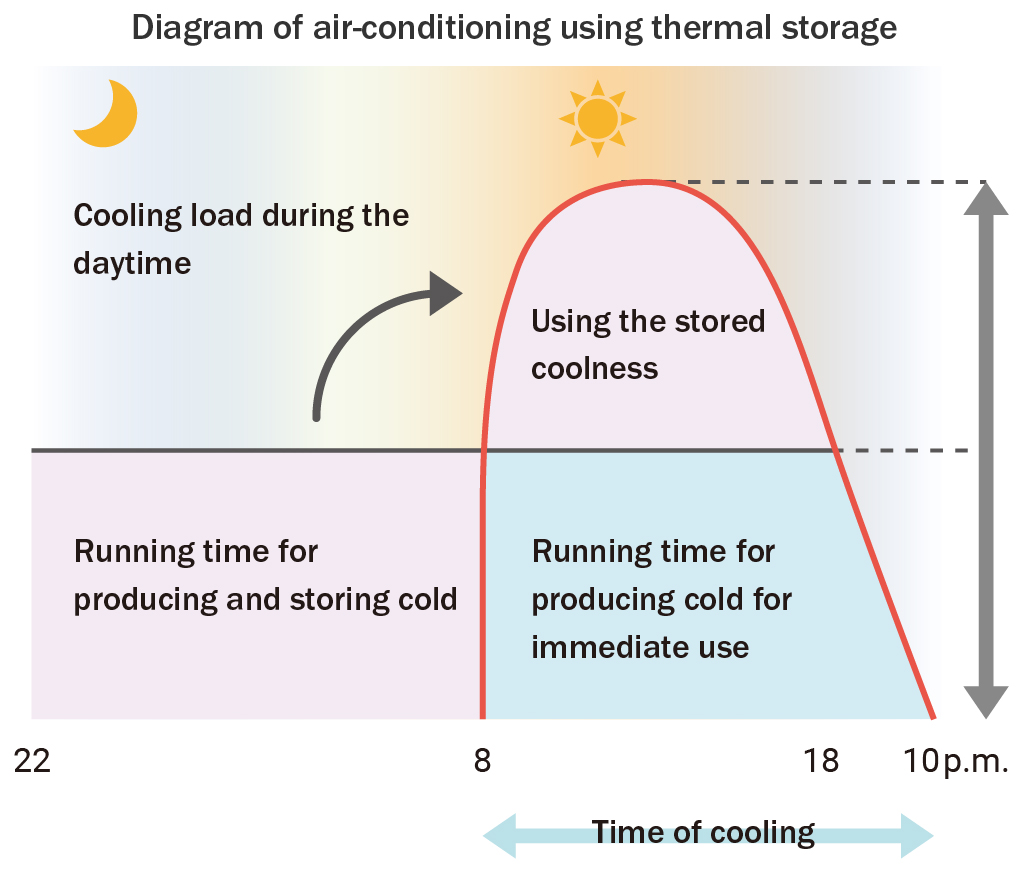
Latent Heat and Sensible Heat Storage Materials
There are two types of heat; sensible heat and latent heat.
Sensible heat is heat that you can observe rising when heated.
Latent heat is a heat energy you cannot confirm by temperature. For example, when solid ice melts into liquid water, it needs heat energy to change its state, but the heat energy consumed for this change cannot be observed through temperature change. The ice in a 0℃ status is still 0℃ when it changes into water and while it consumes heat energy, the temperature does not change.
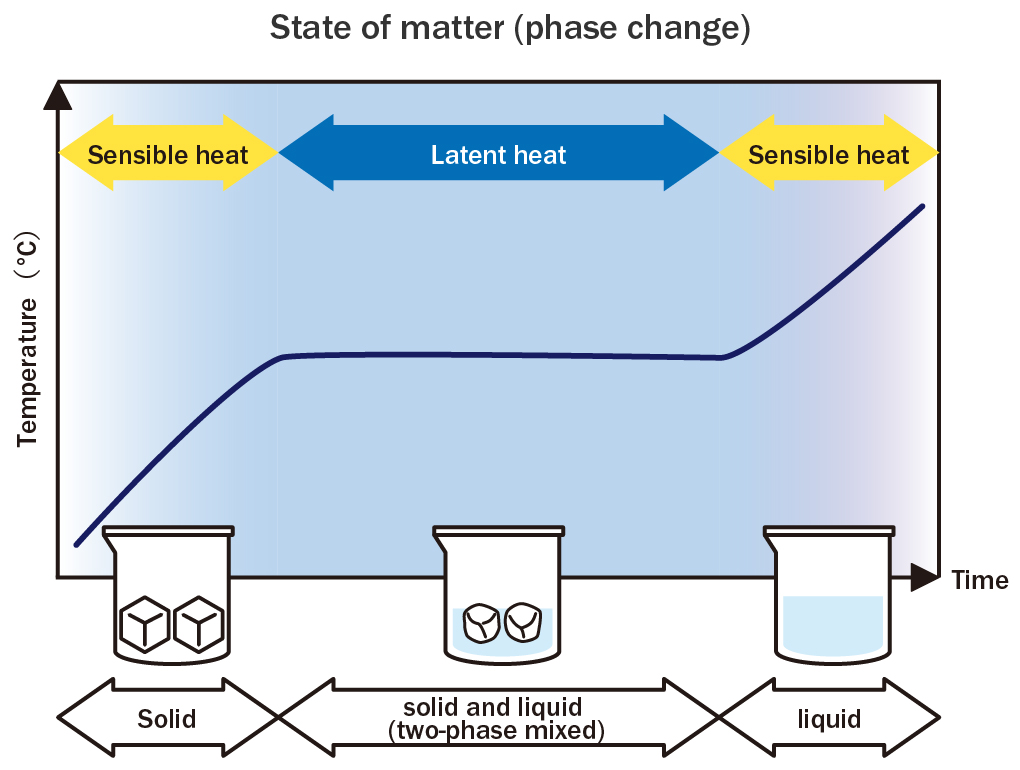
Latent Heat and Sensible Heat in Thermal Storage Materials
■Sensible Heat Thermal Storage
・It has been widely applied for heating by using the affordable nighttime energy effectively.
・It needs a large-scaled system to store heat for the density of thermal storage is low.
・Example of use: for hot-water supply systems with water tanks or heating devices with bricks to store heat.
■Latent Heat Thermal Storage
・The high density of thermal storage allows to store a large quantity of heat in a small capacity storage.
・Works effectively at a fixed temperature.
・The system is easy to build and also very durable.
・It has been attracting attention as a new way to save energy.
■The Difference Between Latent and Sensible Heat Thermal Storage in Building Materials
There are cases when sensible heat requires high heat energy for it absorbs/releases heat in the same specific heat at any temperature range. This causes problems such as room temperature being unable to warm up in winter or cool down in summer. On the other hand, latent heat can use heat energy effectively when the aimed temperature is set around the phase hanging range.
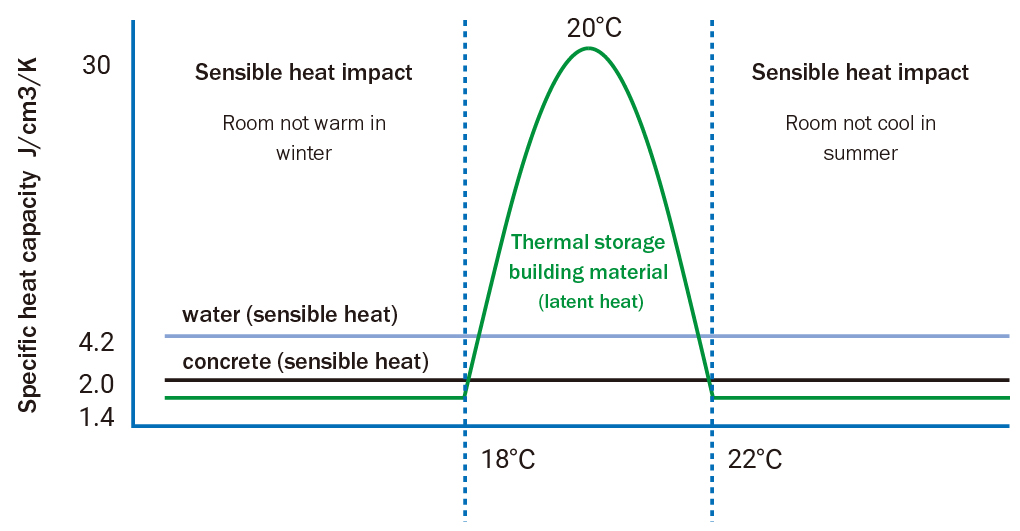
The Mechanism of Thermal Storage Materials
Latent heat thermal storage materials use the heat needed when substances change their phase from solid to liquid and vice versa which is called “latent heat”. Latent heat thermal storage materials use these principles of heat being stored during their heat of fusion and heat of solidification at each melting point.
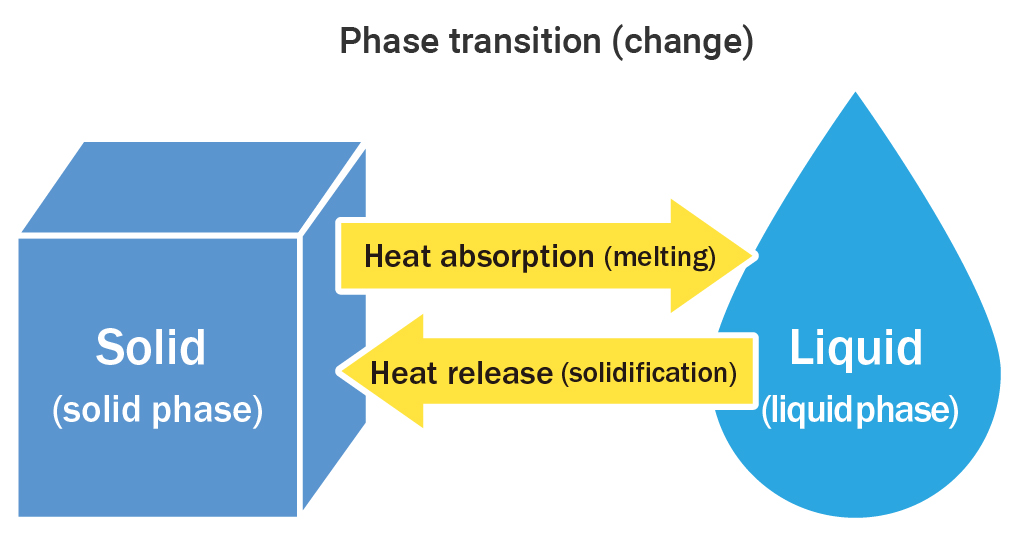
Normal Paraffin, a Fine Latent Heat Thermal Storage Material
■What is Normal Paraffin?
Normal paraffin is a generic term for hydrocarbon with a formula CnH2n+2, which is the ingredient of latent heat thermal storage material.
It is made by separating and refining paraffin and/or vegetable oil according to the number of carbon atoms.

We use normal paraffin with the melting point ranging from -5℃ to 42℃ for our latent heat thermal storage materials.
Normal paraffin is better compared with other latent heat thermal storage materials in the points below.
・Easy-to-use temperature range
・High latent heat energy
・Applicable to heat
・Low inflation/deflation of volume
・Stable to heat and resists high temperature
・Less overcooling
・Reusable with no disruption or separation
・Organic (depending on grade)
・Affordable
・Long-lasting, less deterioration
・Less toxic/pollution of the environment
Thermal Storage Material Lineup
■MIKIRIKEN
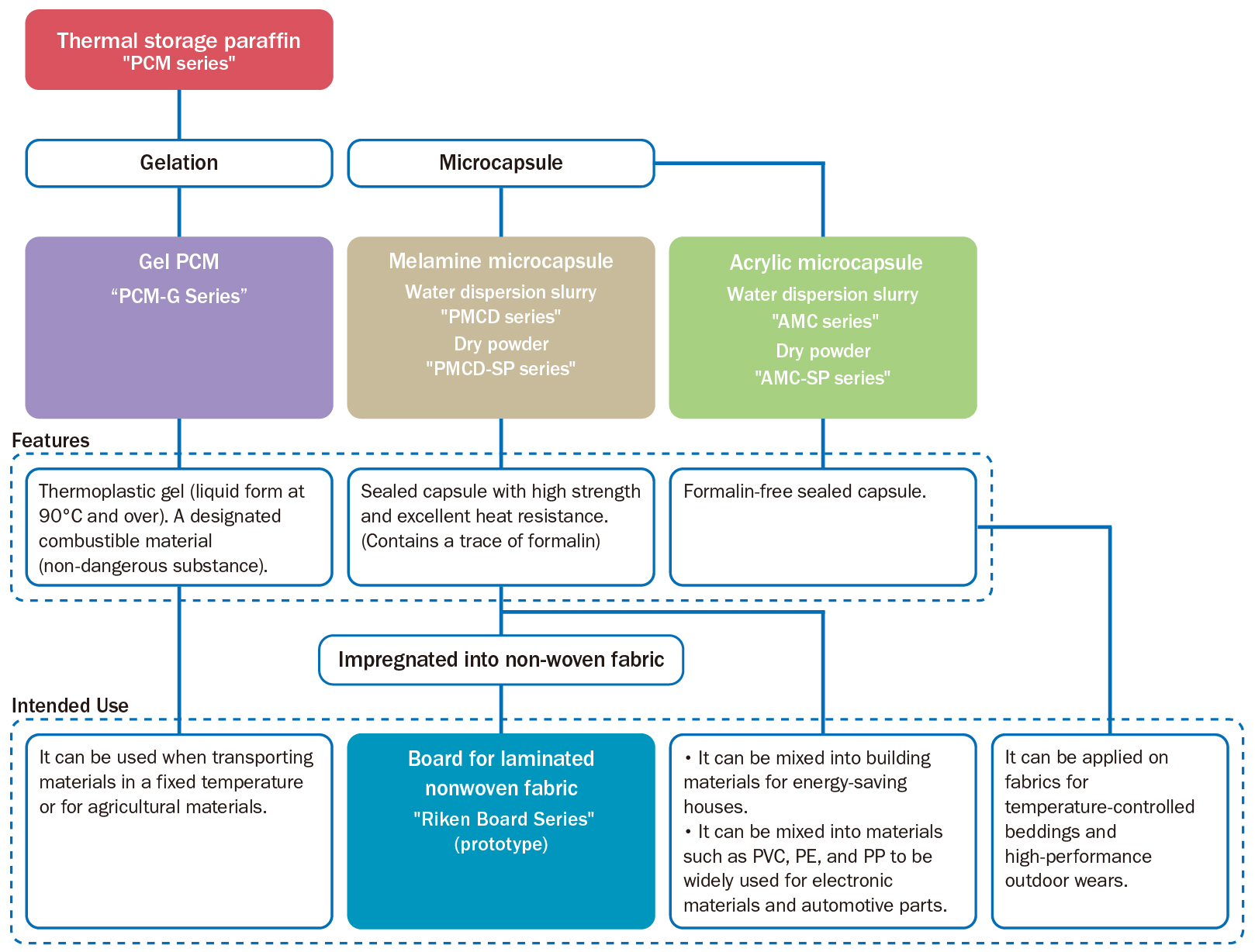
Latent Heat Thermal Storage Paraffins
There are several kinds of latent heat thermal storages, such as salt hydrates, paraffins, organic compounds, and so on. Among these, normal paraffin allows to store heat around 25℃, which is a middle-low temperature range where humans feel comfortable in. It is also resistant to deterioration under repeated phase change, has low toxicity and corrosivity. It has different melting points depending on the number of carbon atoms, so it is possible to store heat at various temperatures.
Lineup

Microcapsules
A microcapsule is a small, closed container ranging from a few μm to several hundred μm.
The capsule consists of a wall and its contents. Microcapsules can be used for various applications by choosing the right wall (shell) and content depending on its purpose.

■Latent Heat Thermal Storage Materials + Microcapsules
It is necessary to put the phase-changing latent heat thermal storage material into a small, leakproof package/container.
By applying our microcapsule technology which we have been developing for 20 years, we have succeeded to fit the paraffin into microcapsules.

■Features of Latent Heat Thermal Storage Microcapsules
・It can be applied on fabrics. It has been highly used on bed mattresses.
・Due to high durability it is easy to mix into resin, has low leakage, and solvent proof.
・Grain size controllable.
・Formalin-free type.
■Shell Types
There are two types of shells, acrylic and melamine to choose from according to your needs.

■Lineup
Melamine
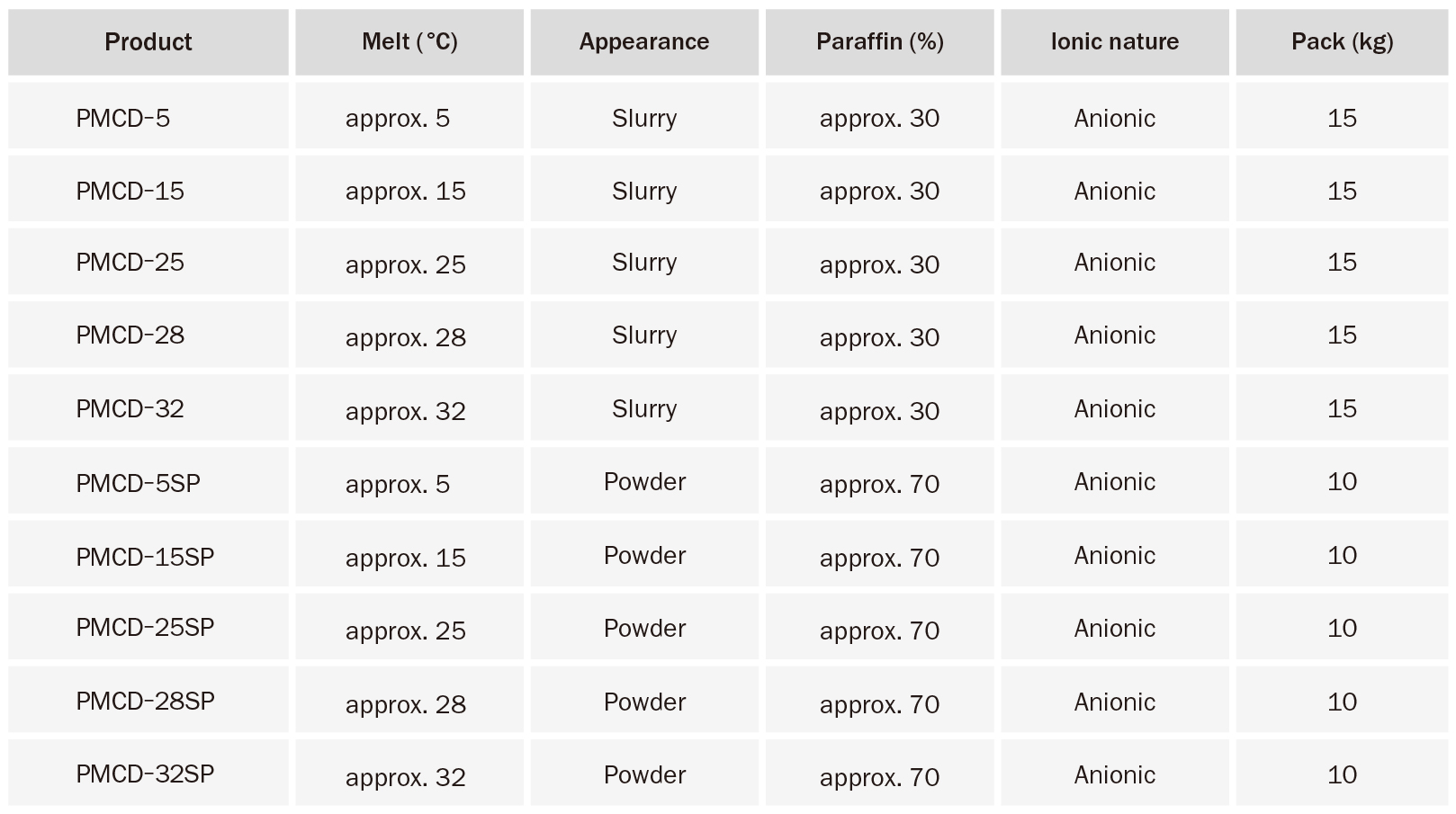
Acrylic

Gel Type Latent Heat Thermal Storage Materials
Normal paraffins with a melting point of 20℃ or less are classified as type 4 dangerous goods and type 3 petroleum, but gelatinized products are listed as non-dangerous goods (flammable solids). Even if you have more than 3000kg in stock, no notifications are necessary besides reporting to the local fire station. (Under the Japanese Fire Service Act)
■Features
・Thanks to our special technology, our gels have 10% more purity than our competitors’ products. This allows us to expect more heat storage using less materials.
・The thermoplastic gel changes into a liquid from at 90℃ so it can be filled up into a container with comparative ease.
■Lineup

Latent Heat Storage Boards (RIKEN BOARD)
RIKEN BOARD is a pressed, non-woven fabric impregnated with latent heat thermal storage microcapsules.
■Features
・It can be made into random thicknesses by layering non-woven fabrics.
・Easy to process.
・Possible to cover the surface with PET. (Prevents stains and wear-outs)
・Officially approved in Japan as energy-saving building materials.
■Standard Lineup(900㎜×1800㎜)

Example of Use
■Beddings
It has been contributing to health and energy saving by using the material in cool feeling mattresses. When laid upon, the thermal storage material will melt inside the capsule causing it to absorb the person’s body heat. When the person rolls over, the part that was under the person will start to solidify which makes the mattress feel cool once more.

■Building Materials
It enables us to use the passive energy of solar heat and nighttime chill by kneading into plaster or using the thermal storage board on air conditioning heat exchangers.
Board member of the Japan Association of Phase Change Material for Buildings
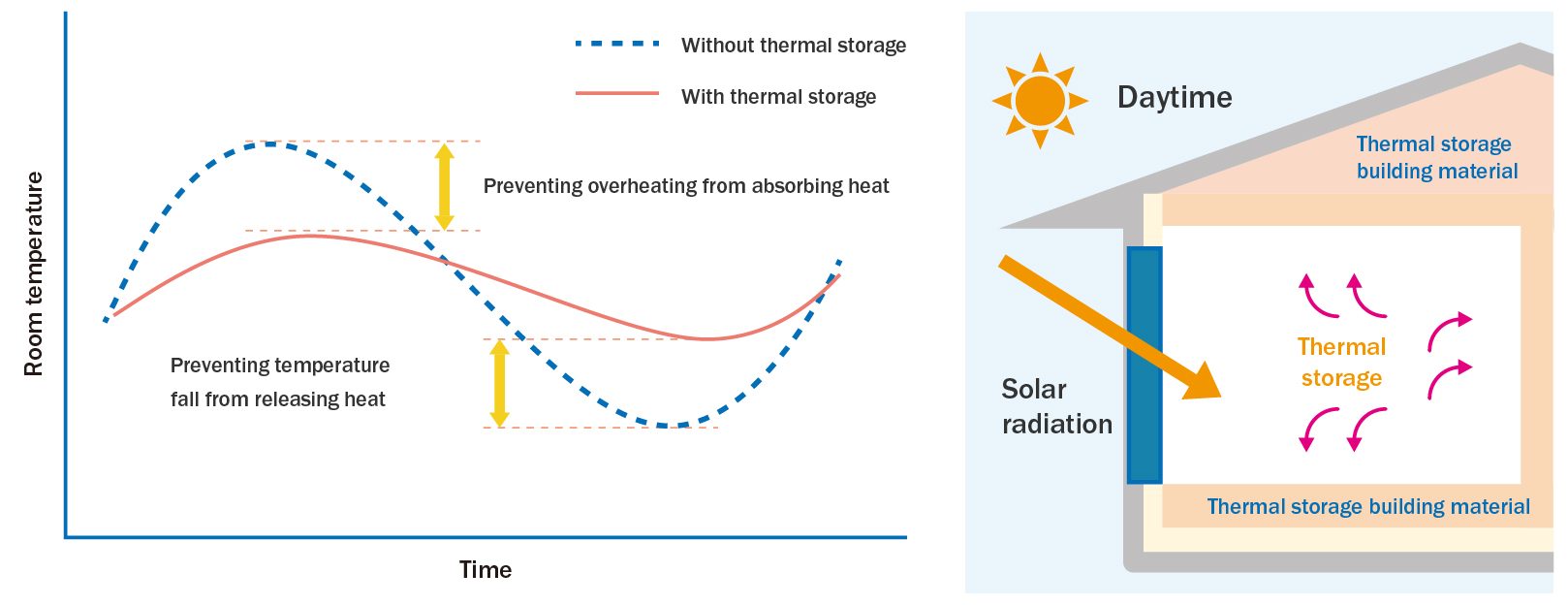
Source: Japan Association of Phase Change Material for Buildings Website
■Automobile Components
It allows components to perform effectively at the fixed temperature by kneading it into resin and other raw materials.
For example, the product is used in automobile components called “canisters”.
Canisters are environmental-friendly products for it prevents air pollution caused by gasoline vapor by using activated carbon inside the fuel tank.
Our latent heat thermal storage material contributes to keep the activated carbon at a certain temperature. These canisters are effective for environmental countermeasures, so they are expected to be applied by more automobile manufacturers.

■Fixed Temperature Transporting
It helps keep the middle temperature range of 15℃ to 20℃ for transporting medical supplies, food, and precision parts without relying on air-conditioning devices.
For example, by transporting cooked rice and other food in a temperature range around 15℃, it prevents the degradation of starch, enabling it to be kept close to a freshly-cooked quality. It is also being used for transporting fruits and vegetables.

It is being used in a carrier for transporting biotechnology samples, investigational drugs, and other medical products. By combining it with thermal storage materials, it allows to keep the temperature ranging from 2℃ to 8℃ or 15℃ to 25℃ for a long time even in harsh temperature change.
Precautions of Use
Please note that the temperature change must be outside the range of the melting and freezing point. The thermal storage material would not change its phase unless the temperature is over its melting point and under its freezing point. Make sure to choose the appropriate preset temperature and location for best performances.
Q&A
Q: Wouldn’t it be hot in the summer in a house with latent heat thermal storage materials installed?
A: No, it wouldn’t.
If the building material with latent heat thermal storage is set to store heat at 23℃, the speed and energy needed to cool the house down by using air-conditioning or nighttime chill is exactly the same as general building materials even if the building is heated up to 23℃ by the solar radiation in summer. It takes some time to cool down if you try to lower the temperature below 23℃ because of heat generation.
It contributes to maintain a comfortable temperature by preventing overheating caused by the solar radiation during the daytime if the room temperature was below 23℃ in the morning.
Please Contact Us!
“Is it possible to use it in this field?”
“Can it be combined with this product?”
“How about a joint study?”
Ask us anything! We are happy to hear any suggestions!